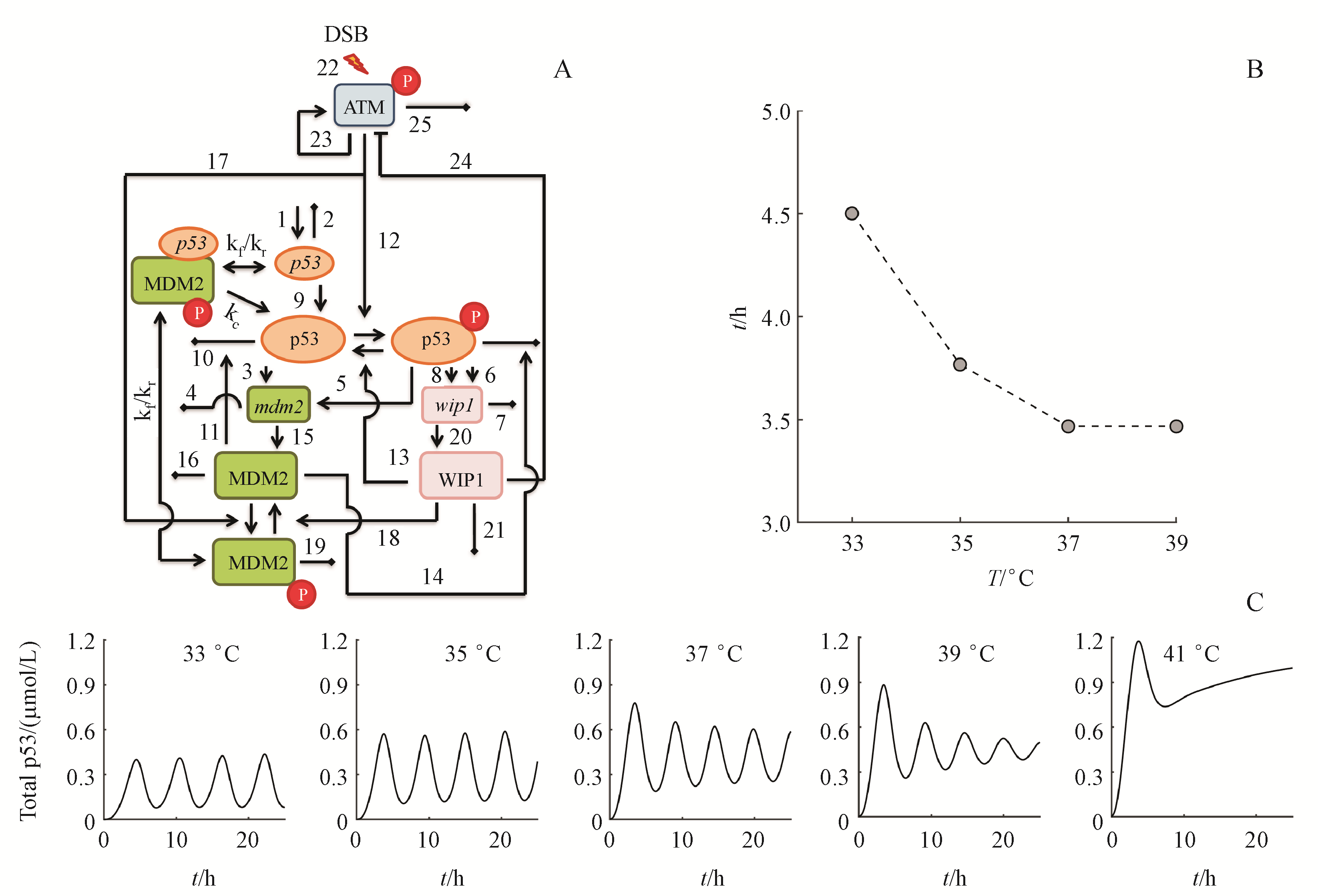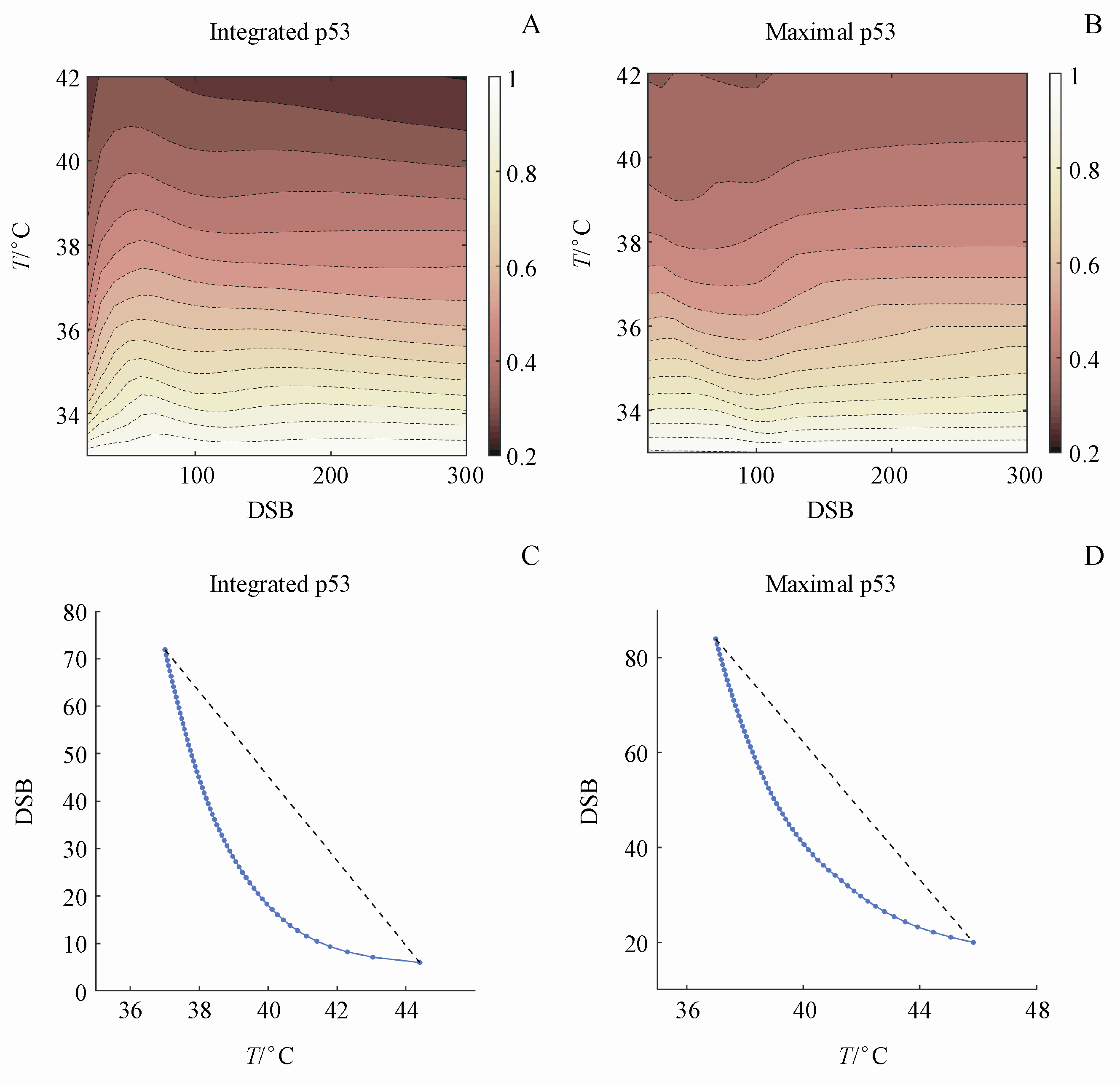摘要
基于p53信号转导网络数学模型研究温度和辐射在调控p53动力学行为过程中的协同效应。利用时滞微分方程构建p53动力学模型,使用加速τ-leap算法进行随机模拟分析,采用Loewe和Bliss协同指数计算协同性,用MATLAB软件进行数值模拟。结果显示,在较低温下,p53脉冲的振幅和特征基音随温度发生转变。p53脉冲的振幅和周期具有较大的变异性。在39 ℃以下,p53首个脉冲的振幅随温度升高而增加,而p53的特征基音则随着温度升高而降低。较温和的高温环境(≥41 ℃)则破坏了p53脉冲,p53蛋白水平呈现持续累积。随着温度的升高,自相关图谱中的周期行为逐渐消失。以p53的累积值和最大值作为评价指标,温度和辐射剂量可产生显著的协同作用。另外,温度对p53动力学的影响是可逆的。总之,温度可显著影响p53的动力学特征。在肿瘤治疗中,热疗亦可为放疗提供有益的帮助。
在对DNA损伤的应答中,维持基因组稳定性对多细胞生物至关重要。细胞内的信号转导网络受到不断变化的生理状态和环境因素影响,其中温度是一个重要因素。研究表明,细胞内的部分信号转导网络(如昼夜节律)具备补偿机制,可对温度变化不敏
转录因子p53是重要的网络节点,可对多种刺激产生响应,并诱导细胞产生一系列应答反应,如细胞周期阻滞、衰老或细胞凋
在静息状态下,人体维持相对稳定的核心温度(约37 ℃)。然而,受环境温度影响,体表温度(尤其在肢端)可降低至约33
本文通过构建微分方程模型,结合随机模拟方法系统模拟了温度对p53动力学的影响。模型也模拟了细胞过热处理后,当温度降至正常体温时p53脉冲的重现。同时,本研究也揭示了温度与辐射剂量的协同效应。此协同性可能为热疗辅助放疗的有效性提供一种新的解释。
基于之前的10变量p53网络模
The total level of ATM was held constant
The first and second order rate constants take the unit mi
温度和辐射剂量的协同通过Loewe和Bliss 协同指数 (combination indexes,CI)进行度
| (1) |
其中d1(温度)和d2(DNA双链断裂DSB)指等效线图(isobologram)中达到40%最大效应时所对应的剂量。和分别代表单独变化温度或DSB的取值并使效应值增加40%时,所需的温度或DSB量。在等效线图中,若图像呈下凸形态,表明系统存在协同性。
Bliss协同指数(CIBliss)定义为:
| (2) |
其中R1(x), R2(y)和R12(x, y)分别指温度为x、DNA双链断裂数量为y,温度-DNA双链断裂组合剂量为[x, y]时,p53效应的相对变化。p53的效应为总p53蛋白水平在时间上的积分和总p53蛋白的最大值。
此模型主要包含两条负反馈环路(p53-MDM2和p53-Wip1-ATM)。模型中,温度(T)影响MDM2和p53的结合,即MDM2对p53的降解作用(表达式见

Figure 1 Effect of temperature on p53 pulses
A: Schematic diagram for p53 signaling network. Arrows indicate activation whereas blunt arrows denote inhibition or degradation; B: Peaking time for the first p53 pulses with increasing temperature; C: Dynamics of total p53 levels in response to increasing temperature
如上所述,在41 ℃过热处理下,确定性常微分方程中总p53的水平在10 h后未有下降趋势。为修正此不足,在随机模拟中,引入DNA损伤修复作用。根据Mönke

Figure 2 Characteristics of p53 pulses are varied with changing temperature
A: Dynamics of p53 with changing temperature in non-irradiated (0 Gy) and irradiated cells (10 Gy) during 25 hours. Two representative stochastic trajectories are shown as black and gray curves. DSB=3 when cells were non-irradiated. The unit is the molecular number; B: Pitch distributions for first three p53 pulses with different temperatures. The IR dose is 10 Gy; C: Distributions of amplitudes for first three p53 pulses for different temperatures; D: Self-correlation for p53 dynamics for different temperatures challenged by 10 Gy IR. Each point in the graph represents the Pearson correlation coefficient for p53 levels at two different time points except for points along the diagonal. The number of replicates is 500 in stochastic simulations
温度可以影响p53的动力学形态,进一步,通过等效线图绘制和计算Bliss协同指数探索温度影响p53信号转导的潜在意义。首先运用累积p53水平作为系统反应指标,计算Bliss协同指数。结果显示,温度和DSB刺激产生了协同效应(CIBliss < 1,

Figure 3 Synergy between temperature and irradiation-induced DNA damage
A: Calculation of Bliss combination indexes between temperature and DNA double strand break (DSB) numbers using temporal integrated p53 levels as the response metric; B: Bliss combination indexes for temperature and DSB numbers using maximal p53 levels as the response; C:Isobologram for integrated p53 responses with respect to DSBs and temperature; D: Isobologram for maximal p53 responses with respect to DSBs and temperature
从p53的累积值响应平面上,可以观察到当温度较低时,累积p53水平沿DSB数量的增加方向上升缓慢;而当温度增高时,辐射刺激的增加可以更为显著提升累积p53水平(

Figure 4 Response surface of p53 features to temperature and DSB numbers
A: Changes of integrated p53 with respect to varying temperature and DSB numbers; B: Changes of maximal p53 with respect to varying temperature and DSB numbers
为进一步模拟实验中发现的p53对温度应答的可逆

Figure 5 Dynamical p53 response to hyperthermia is reversible
A: Stochastic simulations identify the dynamic response of total p53 protein levels to temperature changes. IR = 10 Gy. The initial temperature is 41 °C. After 6 hours, the temperature is lowered to 37 °C. The vertical dashed line is a guide for the 6 h. Two representative stochastic trajectories are shown as black and gray curves. The unit is the molecular number; B: p53 response to temperature changes at populations. The solid black curve denotes the median responses, whereas the dashed black curves represent 25% and 75% quantile, respectively. The distance between the upper and lower dashed lines indicates the interquartile range. The unit is the molecular number; C: 500 stochastic trajectories are represented in a heatmap
p53信号转导网络介导的信息传递过程是机体对环境刺激应答的重要环节。为了探讨温度对p53动力学性质的影响,本研究构建了p53信号通路常微分方程模型。对微分方程的数值求解表明电离辐射刺激下,p53的动力学形态随温度增加发生转变,由脉冲转变为持续累积。同时在33 ℃~39 ℃下,p53脉冲的振幅和周期分布也和温度变化具有强相关性。p53的脉冲也具有一定的异质性(heterogeneity)。模拟结果揭示温度对p53动力学形态调控的生理学意义,即合适的温度和辐射刺激组合具有很强的协同效应,能有效的增强系统中p53的应答反应。p53的脉冲周
在过热条件下,p53脉冲消失,在一定时间内p53呈持续累积的动力学行为。持续的p53累积可能会诱导高水平的关键靶基因表达(例如CDKN1A/p21)从而导致细胞周期阻滞或衰
热疗辅助放疗已被广泛用于临床肿瘤治疗,且此组合疗法具有不良反应小的优
此模型仍有不足,如随机模拟过程中主要考虑了内源性噪声(intrinsic noise),未对模型初值和参数进行随机化,而初值和参数的随机化将更多的引入外源性噪声(extrinsic noise
致谢
穆丹老师帮助本论文顺利完成。References
References
Hastings JW,Sweeney BM. On the mechanism of temperature independence in a biological clock[J]. Proc Natl Acad Sci U S A,1957,43(9):804-811. [百度学术]
Harper CV,Woodcock DJ,Lam C,et al. Temperature regulates NF-κB dynamics and function through timing of A20 transcription[J]. Proc Natl Acad Sci U S A,2018,115(22):E5243-E5249. [百度学术]
Jentsch M,Snyder P,Sheng CB,et al. p53 dynamics in single cells are temperature-sensitive[J]. Sci Rep,2020,10(1):1481. [百度学术]
Batchelor E,Loewer A. Recent progress and open challenges in modeling p53 dynamics in single cells[J]. Curr Opin Syst Biol,2017,3:54-59. [百度学术]
Bieging KT,Mello SS,Attardi LD. Unravelling mechanisms of p53-mediated tumour suppression[J]. Nat Rev Cancer,2014,14(5):359-370. [百度学术]
Wu X,Bayle JH,Olson D,et al. The p53-mdm-2 autoregulatory feedback loop[J]. Genes Dev,1993,7(7a):1126-1132. [百度学术]
Batchelor E,Mock CS,Bhan I,et al. Recurrent initiation:a mechanism for triggering p53 pulses in response to DNA damage[J]. Mol Cell,2008,30(3):277-289. [百度学术]
Marcel V,van Long FN,Diaz JJ. 40 years of research put p53 in translation[J]. Cancers,2018,10(5):152. [百度学术]
Tang QS,Su ZY,Gu W,et al. Mutant p53 on the path to metastasis[J]. Trends Cancer,2020,6(1):62-73. [百度学术]
Gurpinar E,Vousden KH. Hitting cancers' weak spots:vulnerabilities imposed by p53 mutation[J]. Trends Cell Biol,2015,25(8):486-495. [百度学术]
Sund-Levander M,Forsberg C,Wahren LK. Normal oral,rectal,tympanic and axillary body temperature in adult men and women:a systematic literature review[J]. Scand J Caring Sci,2002,16(2):122-128. [百度学术]
Byrne C,Lim CL. The ingestible telemetric body core temperature sensor:a review of validity and exercise applications[J]. Br J Sports Med,2007,41(3):126-133. [百度学术]
Guilherme L,Kalil J. Rheumatic fever and rheumatic heart disease:cellular mechanisms leading autoimmune reactivity and disease[J]. J Clin Immunol,2010,30(1):17-23. [百度学术]
Ó’Fágáin C. Enzyme stabilization—recent experimental progress[J]. Enzym Microb Technol,2003,33(2/3):137-149. [百度学术]
Pelaez F,Manuchehrabadi N,Roy P,et al. Biomaterial scaffolds for non-invasive focal hyperthermia as a potential tool to ablate metastatic cancer cells[J]. Biomaterials,2018,166:27-37. [百度学术]
Sun TZ,Cui J. A plausible model for bimodal p53 switch in DNA damage response[J]. FEBS Lett,2014,588(5):815-821. [百度学术]
Tanaka T,Halicka HD,Traganos F,et al. Induction of ATM activation,histone H2AX phosphorylation and apoptosis by etoposide:relation to cell cycle phase[J]. Cell Cycle,2007,6(3):371-376. [百度学术]
Hirai Y,Hayashi T,Kubo Y,et al. X-irradiation induces up-regulation of ATM gene expression in wild-type lymphoblastoid cell lines,but not in their heterozygous or homozygous Ataxia-telangiectasia counterparts[J]. Jpn J Cancer Res,2001,92(6):710-717. [百度学术]
Hafner A,Bulyk ML,Jambhekar A,et al. The multiple mechanisms that regulate p53 activity and cell fate[J]. Nat Rev Mol Cell Biol,2019,20(4):199-210. [百度学术]
Walerych D,Olszewski MB,Gutkowska M,et al. Hsp70 molecular chaperones are required to support p53 tumor suppressor activity under stress conditions[J]. Oncogene,2009,28(48):4284-4294. [百度学术]
Arrhenius S. Über die Reaktionsgeschwindigkeit bei der Inversion von Rohrzucker durch Säuren[J]. Z Physik Chem,1889,4:226-248. [百度学术]
Gajjar M,Candeias MM,Malbert-Colas L,et al. The p53 mRNA-Mdm2 interaction controls Mdm2 nuclear trafficking and is required for p53 activation following DNA damage[J]. Cancer Cell,2012,21(1):25-35. [百度学术]
Chatterjee A,Vlachos DG,Katsoulakis MA. Binomial distribution based tau-leap accelerated stochastic simulation[J]. J Chem Phys,2005,122(2):024112. [百度学术]
Foucquier J,Guedj M. Analysis of drug combinations:current methodological landscape[J]. Pharmacol Res Perspect,2015,3(3):e00149. [百度学术]
Hsing A,Faller DV,Vaziri C. DNA-damaging aryl hydrocarbons induce Mdm2 expression via p53-independent post-transcriptional mechanisms[J]. J Biol Chem,2000,275(34):26024-26031. [百度学术]
Ju J,Schmitz JC,Song B,et al. Regulation of p53 expression in response to 5-fluorouracil in human cancer RKO cells[J]. Clin Cancer Res,2007,13(14):4245-4251. [百度学术]
Mayo LD,Dixon JE,Durden DL,et al. PTEN protects p53 from Mdm2 and sensitizes cancer cells to chemotherapy[J]. J Biol Chem,2002,277(7):5484-5489. [百度学术]
Rossi M,Demidov ON,Anderson CW,et al. Induction of PPM1D following DNA-damaging treatments through a conserved p53 response element coincides with a shift in the use of transcription initiation sites[J]. Nucleic Acids Res,2008,36(22):7168-7180. [百度学术]
Ma L,Wagner J,Rice JJ,et al. A plausible model for the digital response of p53 to DNA damage[J]. Proc Natl Acad Sci U S A,2005,102(40):14266-14271. [百度学术]
Vilenchik MM,Knudson AG. Endogenous DNA double-strand breaks:production,fidelity of repair,and induction of cancer[J]. Proc Natl Acad Sci U S A,2003,100(22):12871-12876. [百度学术]
Mönke G,Cristiano E,Finzel A,et al. Excitability in the p53 network mediates robust signaling with tunable activation thresholds in single cells[J]. Sci Rep,2017,7:46571. [百度学术]
Harton MD,Koh WS,Bunker AD,et al. p53 pulse modulation differentially regulates target gene promoters to regulate cell fate decisions[J]. Mol Syst Biol,2019,15(9):e8685. [百度学术]
Chen X,Chen J,Gan ST,et al. DNA damage strength modulates a bimodal switch of p53 dynamics for cell-fate control[J]. BMC Biol,2013,11:73. [百度学术]
Yang RZ,Huang B,Zhu YT,et al. Cell type-dependent bimodal p53 activation engenders a dynamic mechanism of chemoresistance[J]. Sci Adv,2018,4(12):eaat5077. [百度学术]
Purvis JE,Karhohs KW,Mock C,et al. p53 dynamics control cell fate[J]. Science,2012,336(6087):1440-1444. [百度学术]
Soares PI,Ferreira IM,Igreja RA,et al. Application of hyperthermia for cancer treatment:recent patents review[J]. Recent Pat Anticancer Drug Discov,2012,7(1):64-73. [百度学术]
Ohnstad HO,Castro R,Sun JC,et al. Correlation of TP53 and MDM2 genotypes with response to therapy in sarcoma[J]. Cancer,2013,119(5):1013-1022. [百度学术]
Keizer EM,Bastian B,Smith RW,et al. Extending the linear-noise approximation to biochemical systems influenced by intrinsic noise and slow lognormally distributed extrinsic noise[J]. Phys Rev E,2019,99(5-1):052417. [百度学术]